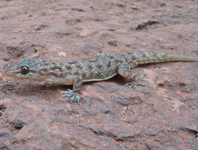Abstract
A new rupicolous gecko from the Hemidactylus brookii complex is described from the forests and plateaus of Amboli, in the Western Ghats of Maharashtra. This medium sized (average adult SVL 56.2±5.0 to at least 62 mm), nocturnal species is superficially similar to other congeners from the ‘H. brookii’ clade, but can be distinguished from them in having 17 or 18 fairly regular longitudinal rows of enlarged, conical, keeled tubercles at midbody, extending from posterior part of the head to groin; tubercles in parasagittal rows smaller, feebly keeled and more rounded; approximately six rows of tubercles on either side of parasagittal tubercle rows, highly enlarged, remarkably conical and strongly keeled; lamellae divided in a straight transverse series—seven or eight lamellae beneath fourth digit (manus and pes) and five or six beneath first digit (manus and pes). Males with nine or ten (rarely eight) femoral pores separated by four or five poreless scales; supralabials 11–13; infralabials 8–11. Molecular data based on the mitochondrial ND2 gene supports the distinctiveness of this species and helps ascertain its phylogenetic position within the ‘H. brookii’ group of the Indian Hemidactylus radiation.
References
Agarwal, I., Giri, V.B. & Bauer, A. (2011) A new cryptic rock dwelling Hemidactylus (Squamata: Gekkonidae) from south India. Zootaxa, 2765 (1), 21–37.
https://doi.org/10.11646/zootaxa.2765.1.2
Agarwal, I., Bauer, A.M., Giri, V.B. & Khandekar, A. (2019) An expanded ND2 phylogeny of the brookii and prashadi groups with the description of three new Indian Hemidactylus Oken (Squamata: Gekkonidae). Zootaxa, 4619 (3), 431–458.
https://doi.org/10.11646/zootaxa.4619.3.2
Bansal, R. & Karanth, K.P. (2010) Molecular phylogeny of Hemidactylus geckos (Squamata: Gekkonidae) of the Indian subcontinent reveals a unique Indian radiation and an Indian origin of Asian house geckos. Molecular Phylogenetics and Evolution, 57 (1), 459–465.
https://doi.org/10.1016/j.ympev.2010.06.008
Bauer, A.M., Jackman, T.R., Greenbaum, E., Giri, V.B. & De Silva, A. (2010a) South Asia supports a major endemic radiation of Hemidactylus geckos. Molecular Phylogenetics and Evolution, 57 (1), 343–352.
https://doi.org/10.1016/j.ympev.2010.06.014
Bauer, A.M., Jackman, T.R., Greenbaum, E., de Silva, A., Giri, V.B. & Das, I. (2010b) Molecular evidence for the taxonomic status of Hemidactylus brookii group taxa (Squamata: Gekkonidae). Herpetological Journal, 20 (3), 129–138.
Boulenger, G.A. (1885) Catalogue of the Lizards in the British Museum (Natural History). Vol. 1. Gekkonidae, Eublepharidae, Uroplatidae, Pygopodidae, Agamidae. 2nd Edition. Trustees of the British Museum (Natural History), London, xii + 436 pp., pls. I–XXXII.
Boulenger, G.A. (1898) XVIII.—A list of reptiles and batrachians from Ombaai, East Indian Archipelago. Annals and Magazine of Natural History, Series 7, 1 (2), 122–124.
https://doi.org/10.1080/00222939808677938
Brown, W.C. & Alcala, A.C. (1978) Philippine Lizards of the Family Gekkonidae. Monograph Series 1. Silliman University Press, Dumaguete City, Philippines. 146 pp.
Chaitanya, R., Lajmi, A. & Giri, V.B. (2018) A new cryptic, rupicolous species of Hemidactylus Oken, 1817 (Squamata: Gekkonidae) from Meghamalai, Tamil Nadu, India. Zootaxa, 4374 (1), 49–70.
https://doi.org/10.11646/zootaxa.4374.1.3
De Rooij, N. (1915) Lacertilia, Chelonia, Emydosauria. In: The Reptiles of the Indo-Australian Archipelago. E. J. Brill Ltd, Leiden, xiv + 384 pp.
https://doi.org/10.5962/bhl.title.10610
Kanade, R., Tadwalkar, M., Kushalappa, C. & Patwardhan A. (2008) Vegetation composition and woody species diversity at Chandoli National Park, northern Western Ghats, India. Current Science, 95 (5), 637– 646.
Kathriner, A., O’Shea, M. & Kaiser, H. (2014) Re-examination of Hemidactylus tenkatei van Lidth de Jeude, 1895: populations from Timor provide insight into the taxonomy of the H. brookii Gray, 1845 complex (Squamata: Gekkonidae). Zootaxa, 3887 (5), 583–599.
https://doi.org/10.11646/Zootaxa.3887.5.5
Lajmi, A., Giri, V.B. & Karanth, K.P. (2016) Molecular data in conjunction with morphology help resolve the Hemidactylus brookii complex (Squamata: Gekkonidae). Organisms Diversity & Evolution, 16 (3), 659–677.
https://doi.org/10.1007/s13127-016-0271-9
Mirza, Z.A. & Raju, D. (2017) A new rupicolous species of gecko of the genus Hemidactylus Oken, 1817 from the Satpura Hills, Central India. Amphibian & Reptile Conservation, 11 (1), e137, 51–71.
Mirza, Z.A., Gowande, G.G., Patil, R., Ambekar, M. & Patel, H. (2018) First appearance deceives many: disentangling the Hemidactylus triedrus species complex using an integrated approach. PeerJ, 6, e5341.
https://doi.org/10.7717/peerj.5341
Mahony, S. (2011) Taxonomic revision of Hemidactylus brookii Gray: a re-examination of the type series and some Asian synonyms, and a discussion of the obscure species Hemidactylus subtriedrus Jerdon (Reptilia: Gekkonidae). Zootaxa, 3042 (1), 37–67.
https://doi.org/10.11646/zootaxa.3042.1.4
Punekar, J., Mateo, P. & Keller, G. (2014) Effects of Deccan volcanism on paleoenvironment and planktic foraminifera: A global survey. In: Keller, G. & Kerr, A.C. (Eds), Volcanism, Impacts, and Mass Extinctions: Causes and Effects. Geological Society of America Special Paper, 505, pp. 91–116.
https://doi.org/10.1130/2014.2505(04)
Stamatakis, A. (2014) RAxML Version 8: A tool for phylogenetic analysis and post-analysis of large phylogenies. Bioinformatics, 30 (9), 1312–1313.
https://doi.org/10.1093/bioinformatics/btu033
Srikanthan, A.N., Swamy, P., Mohan, A.V & Pal, S. (2018) A distinct new species of riparian rock-dwelling gecko (genus: Hemidactylus) from the southern Western Ghats. Zootaxa, 4434 (1), 141–157.
https://doi.org/10.11646/zootaxa.4434.1.9
Tamura, K., Peterson, D., Peterson, N., Stecher, G., Nei, M. & Kumar, S. (2011) MEGA5: molecular evolutionary genetics analysis using maximum likelihood, evolutionary distance, and maximum parsimony methods. Molecular Biology & Evolution, 28 (10), 2731–2739.
https://doi.org/10.1093/molbev/msr121
Thompson, J.D., Higgins, D.G. & Gibson, T.J. (1994) CLUSTAL W: improving the sensitivity of progressive multiple sequence alignment through sequence weighting, positions-specific gap penalties and weight matrix choice. Nucleic Acids Research, 22 (22), 4673–4680.
https://doi.org/10.1093/nar/22.22.4673
Zug, G.R., Vindum, J.V. & Koo, M. (2007) Burmese Hemidactylus (Reptilia, Squamata, Gekkonidae): taxonomic notes on the tropical Asian Hemidactylus. Proceedings of the California Academy of Sciences, 58, 387–405.

